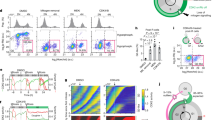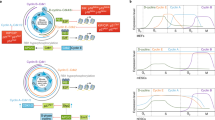Abstract
There is a short window in the mammalian cell cycle during which cells can respond to extracellular cues by withdrawing temporarily from the cell cycle. When these cells re-enter the cell cycle, they require several extra hours in the G1 phase before they replicate their DNA compared with their cycling counterparts. More than 20 years after this initial observation, we still do not understand what is taking so long.
This is a preview of subscription content, access via your institution
Access options
Subscribe to this journal
Receive 12 print issues and online access
$189.00 per year
only $15.75 per issue
Buy this article
- Purchase on Springer Link
- Instant access to full article PDF
Prices may be subject to local taxes which are calculated during checkout



Similar content being viewed by others
References
Pardee, A. B. A restriction point for control of normal animal cell proliferation. Proc. Natl Acad. Sci. USA 71, 1286–1290 (1974).
Planas-Silva, M. D. & Weinberg, R. A. The restriction point and control of cell proliferation. Curr. Opin. Cell Biol. 9, 768–772 (1997).
Smith, J. A. & Martin, L. Do cells cycle? Proc. Natl Acad. Sci. USA 70, 1263–1267 (1973).
Martin, R. G. & Stein, S. Resting state in normal and simian virus 40 transformed Chinese hamster lung cells. Proc. Natl Acad. Sci. USA 73, 1655–1659 (1976).
Zetterberg, A. & Larsson, O. Kinetic analysis of regulatory events in G1 leading to proliferation or quiescence of Swiss 3T3 cells. Proc. Natl Acad. Sci. USA 82, 5365–5369 (1985).
Lajtha, L. G. On the concept of the cell cycle. J. Cell Physiol. 62 (Suppl. 1), 143–145 (1963).
Sage, J., Miller, A. L., Perez-Mancera, P. A., Wysocki, J. M. & Jacks, T. Acute mutation of retinoblastoma gene function is sufficient for cell cycle re-entry. Nature 424, 223–228 (2003).
Lavoie, J. N., L'Allemain, G., Brunet, A., Muller, R. & Pouyssegur, J. Cyclin D1 expression is regulated positively by the p42/p44MAPK and negatively by the p38/HOGMAPK pathway. J. Biol. Chem. 271, 20608–20616 (1996).
Aktas, H., Cai, H. & Cooper, G. M. Ras links growth factor signaling to the cell cycle machinery via regulation of cyclin D1 and the Cdk inhibitor p27KIP1. Mol. Cell. Biol. 17, 3850–3857 (1997).
Kerkhoff, E. & Rapp, U. R. Induction of cell proliferation in quiescent NIH 3T3 cells by oncogenic c-Raf-1. Mol. Cell. Biol. 17, 2576–2586 (1997).
Cheng, M., Sexl, V., Sherr, C. J. & Roussel, M. F. Assembly of cyclin D-dependent kinase and titration of p27Kip1 regulated by mitogen-activated protein kinase kinase (MEK1). Proc. Natl Acad. Sci. USA 95, 1091–1096 (1998).
Harbour, J. W., Luo, R. X., Dei Santi, A., Postigo, A. A. & Dean, D. C. Cdk phosphorylation triggers sequential intramolecular interactions that progressively block Rb functions as cells move through G1. Cell 98, 859–869 (1999).
DeGregori, J., Kowalik, T. & Nevins, J. R. Cellular targets for activation by the E2F1 transcription factor include DNA synthesis- and G1/S-regulatory genes. Mol. Cell. Biol. 15, 4215–4224 (1995).
Trimarchi, J. M. & Lees, J. A. Sibling rivalry in the E2F family. Nature Rev. Mol. Cell Biol. 3, 11–20 (2002).
Owen, T. A., Soprano, D. R. & Soprano, K. J. Analysis of the growth factor requirements for stimulation of WI-38 cells after extended periods of density-dependent growth arrest. J. Cell Physiol. 139, 424–431 (1989).
Blow, J. J. & Dutta, A. Preventing re-replication of chromosomal DNA. Nature Rev. Mol. Cell Biol. 6, 476–486 (2005).
Stoeber, K. et al. DNA replication licensing and human cell proliferation. J. Cell Sci. 114, 2027–2041 (2001).
Eward, K. L. et al. DNA replication licensing in somatic and germ cells. J. Cell Sci. 117, 5875–5886 (2004).
Kingsbury, S. R. et al. Repression of DNA replication licensing in quiescence is independent of geminin and may define the cell cycle state of progenitor cells. Exp. Cell Res. 309, 56–67 (2005).
Jiang, W., Wells, N. J. & Hunter, T. Multistep regulation of DNA replication by Cdk phosphorylation of HsCdc6. Proc. Natl Acad. Sci. USA 96, 6193–6198 (1999).
Mailand, N. & Diffley, J. F. CDKs promote DNA replication origin licensing in human cells by protecting Cdc6 from APC/C-dependent proteolysis. Cell 122, 915–926 (2005).
Coller, H. A., Sang, L. & Roberts, J. M. A new description of cellular quiescence. PLoS Biol. 4, e83 (2006).
Arias, E. E. & Walter, J. C. Strength in numbers: preventing rereplication via multiple mechanisms in eukaryotic cells. Genes Dev. 21, 497–518 (2007).
Stoeber, K. et al. Cdc6 protein causes premature entry into S phase in a mammalian cell-free system. EMBO J. 17, 7219–7229 (1998).
Madine, M. A. et al. The roles of the MCM, ORC, and Cdc6 proteins in determining the replication competence of chromatin in quiescent cells. J. Struct. Biol. 129, 198–210 (2000).
Priori, L. & Ubezio, P. Mathematical modelling and computer simulation of cell synchrony. Methods Cell Sci. 18, 83–91 (1996).
Zhu, W., Giangrande, P. H. & Nevins, J. R. E2Fs link the control of G1/S and G2/M transcription. EMBO J. 23, 4615–4626 (2004).
Petersen, B. O., Lukas, J., Sorensen, C. S., Bartek, J. & Helin, K. Phosphorylation of mammalian CDC6 by cyclin A/CDK2 regulates its subcellular localization. EMBO J. 18, 396–410 (1999).
Elsasser, S., Chi, Y., Yang, P. & Campbell, J. L. Phosphorylation controls timing of Cdc6p destruction: a biochemical analysis. Mol. Biol. Cell 10, 3263–3677 (1999).
Sanchez, M., Calzada, A. & Bueno, A. The Cdc6 protein is ubiquitinated in vivo for proteolysis in Saccharomyces cerevisiae. J. Biol. Chem. 274, 9092–9097 (1999).
Drury, L. S., Perkins, G. & Diffley, J. F. The Cdc4/34/53 pathway targets Cdc6p for proteolysis in budding yeast. EMBO J. 16, 5966–5976 (1997).
Wirth, K. G. et al. Loss of the anaphase-promoting complex in quiescent cells causes unscheduled hepatocyte proliferation. Genes Dev. 18, 88–98 (2004).
Coverley, D., Laman, H. & Laskey, R. A. Distinct roles for cyclins E and A during DNA replication complex assembly and activation. Nature Cell Biol. 4, 523–528 (2002).
Geng, Y. et al. Cyclin E ablation in the mouse. Cell 114, 431–443 (2003).
Geng, Y. et al. Kinase-independent function of cyclin E. Mol. Cell 25, 127–139 (2007).
Mendelsohn, M. L. Autoradiographic analysis of cell proliferation in spontaneous breast cancer of C3H mouse. III. The growth fraction. J. Natl Cancer Inst. 28, 1015–1029 (1962).
Pardee, A. B. A restriction point for control of normal animal cell proliferation. Proc. Natl Acad. Sci. USA 71, 1286–1290 (1974).
Baserga, R., Costlow, M. & Rovera, G. Changes in membrane function and chromatin template activity in diploid and transformed cells in culture. Fed. Proc. 32, 2115–2118 (1973).
Burstin, S. J., Meiss, H. K. & Basilico, C. A temperature-sensitive cell cycle mutant of the BHK cell line. J. Cell Physiol. 84, 397–408 (1974).
Schneider, C., King, R. M. & Philipson, L. Genes specifically expressed at growth arrest of mammalian cells. Cell 54, 787–793 (1988).
Coppock, D. L., Kopman, C., Scandalis, S. & Gilleran, S. Preferential gene expression in quiescent human lung fibroblasts. Cell Growth Differ. 4, 483–493 (1993).
Polyak, K. et al. p27Kip1, a cyclin–Cdk inhibitor, links transforming growth factor-β and contact inhibition to cell cycle arrest. Genes Dev. 8, 9–22 (1994).
Acknowledgements
H.A.C. is the Milton E. Cassel scholar of the Rita Allen Foundation. She is grateful to L. Fischer, L. Kruglyak and A. Legesse-Miller for helpful comments.
Author information
Authors and Affiliations
Ethics declarations
Competing interests
The author declares no competing financial interests.
Related links
Rights and permissions
About this article
Cite this article
Coller, H. What's taking so long? S-phase entry from quiescence versus proliferation. Nat Rev Mol Cell Biol 8, 667–670 (2007). https://doi.org/10.1038/nrm2223
Issue Date:
DOI: https://doi.org/10.1038/nrm2223
This article is cited by
-
Pharmacodynamic modeling of synergistic birinapant/paclitaxel interactions in pancreatic cancer cells
BMC Cancer (2020)
-
The cytotoxic mechanism of epigallocatechin gallate on proliferative HaCaT keratinocytes
Journal of Biomedical Science (2017)
-
Multiple molecular interactions redundantly contribute to RB-mediated cell cycle control
Cell Division (2017)
-
Meta-analysis reveals conserved cell cycle transcriptional network across multiple human cell types
BMC Genomics (2017)
-
γ-Tocotrienol prevents cell cycle arrest in aged human fibroblast cells through p16INK4a pathway
Journal of Physiology and Biochemistry (2017)



